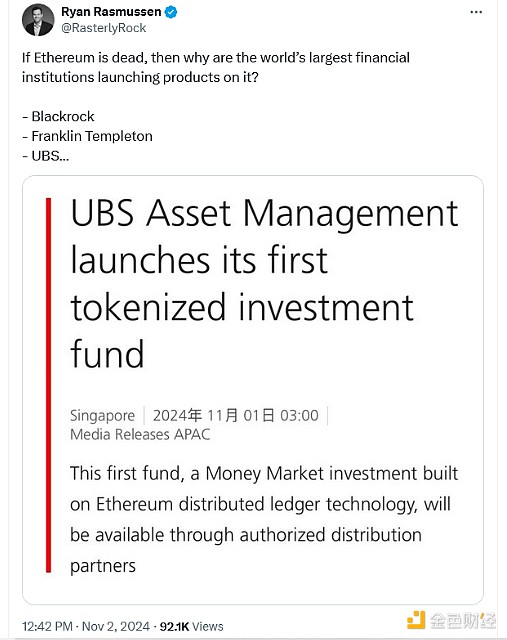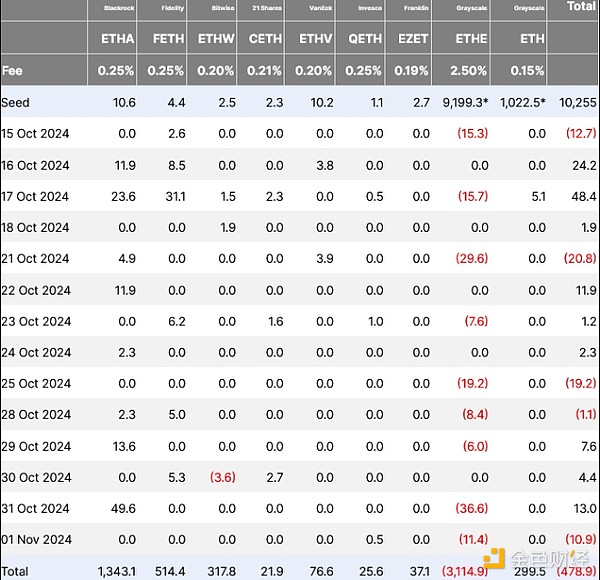Author: Brayden Lindrea, CoinTelegraph; Compiler: Tao Zhu, Golden Finance
A research analyst at crypto asset management company 21Shares said that Wall Street investors are still largely unaware of the potential of Ethereum, just like Amazon in the early 1990s before it became a $2 trillion tech giant.
The spot Ethereum exchange-traded fund was launched in July, but inflows have been relatively small compared to spot Bitcoin ETFs.
Leena ElDeeb, research analyst at 21Shares, pointed out that only if the potential of Ethereum is understood will the ETH ETF see a large inflow of funds.
Ethereum is “complex and akin to Amazon in the 1990s — huge potential, but less straightforward use cases,” Eldeeb said.
Federico Brokate, vice president and head of U.S. operations at 21Shares, added that while Amazon started out as an online bookstore, “few could have predicted its transformation into a global e-commerce and cloud computing giant, reinventing the way we shop and use digital services.”
Similarly, Ethereum began as a platform to support basic smart contracts and now supports more than $140 billion worth of decentralized finance applications since its launch in 2015.
“Just as Amazon transcended books and redefined an entire industry, Ethereum could surprise us with revolutionary use cases that we can’t fully imagine today.”
While Ethereum’s $320 billion market cap is only 6.25% of Amazon’s $2 trillion valuation, Brokate noted that one advantage Ethereum had over Amazon in the 1990s was the large pool of talent dedicated to making the network useful.
“By the late 1990s, Amazon employed approximately 7,600 people. In contrast, the Ethereum network today has over 200,000 active developers — including software engineers, researchers, and protocol designers — all contributing to its growth,” Brokate said, adding:
“Amazon has grown to over 1.5 million employees worldwide, and we may see similar growth in the Ethereum ecosystem.”
Ethereum continues to dominate decentralized exchanges, lending, stablecoins, and real-world asset markets, despite challenges from Solana and other Layer-1 competitors.
BlackRock, the world’s largest asset manager, has tokenized more than $533 million worth of money market funds on Ethereum. More recently, UBS launched its own tokenized fund on November 1.

Source: Ryan Rasmussen
Payment companies PayPal and Visa are also developing on Ethereum.
However, "only a few investors understand the potential of Ethereum," and many choose to "wait and see" the spot Ethereum ETF for the time being, Brokate pointed out.
Short-term investors remain “cautious” and are reluctant to invest in spot Ethereum ETFs until Ethereum’s potential and use cases are “clearer,” ElDeeb added.
“[However] we remain optimistic that investor sentiment and adoption will follow a similar path of continued growth as the market matures and Ethereum’s diverse applications grow.”
Sygnum Bank head of research Katalin Tischhauser noted that, excluding Grayscale’s outflows, inflows into spot Ethereum ETFs were just 9% of those into spot Bitcoin ETFs in the first 90 days.
Tischhauser noted that this was largely expected, as investors were still “digesting” spot Bitcoin ETFs due to the short marketing period and the fact that staking is not permitted by U.S. securities regulators.
But Tischhauser said that in 12 months, investors will have more time to consider the bull case for Ethereum, and the situation may be "very different" by then.
Therefore, she is not concerned about the number of spot Ethereum ETF issuers that have recently continued to record "0" flows.
"It is too early to talk about delisting now, and traditional investors need time."

In the past few weeks, several spot Ethereum ETFs have recorded dozens of "0" flows. Source: Farside Investors
21Shares, one of eight U.S. spot Ethereum ETF issuers, has received $21.9 million in net inflows.
Tischhauser said the lack of institutional flows could be attributed to Ethereum’s Layer 2 scaling strategy, which is cannibalizing Ethereum mainnet revenue.
CK Zheng, chief investment officer at crypto hedge fund ZX Squared Capital, noted that the decline in Ethereum revenue could be off-putting to many Wall Street investors who like to implement cash flow analysis for valuation purposes.
But similar to Amazon’s losses for several consecutive quarters in the 1990s, Brokate isn’t concerned about Ethereum’s recent revenue woes because its Layer 2 scaling strategy is attracting millions of new customers at low cost.
Eventually, Layer 2 fees will become “large enough” to return Ethereum mainnet fees to pre-blob levels, Brokate said.
 Joy
Joy







